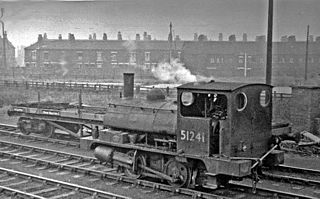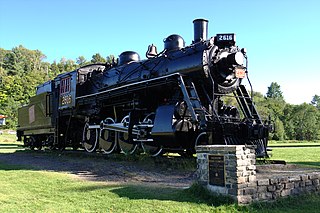
The British Railways Standard Class 4 4-6-0 is a class of steam locomotives, 80 of which were built during the 1950s. Six have been preserved.

The Highland Railway's Clan Goods class was a class of steam locomotive. They were designed by Christopher Cumming. The first four were built by Hawthorn Leslie and Company on Tyneside, and the maker's plates bore the date 1917, but because of wartime delays were not delivered until 1918. Four more were built in 1919, also by Hawthorn Leslie.

The Highland Railway F class 4-4-0s were a class of British steam locomotives introduced in 1874. The first 10 were built by Dübs and Company in 1874. A further seven were built in Lochgorm works between 1876 and 1888. Originally they were the first Bruce class, and later became known as the Duke class to avoid confusion with the second Bruce class. As part of Peter Drummond's 1901 classification scheme they became class F.

The Great Western Railway (GWR) 2800 Class is a class of Churchward-designed 2-8-0 steam locomotive.

The L&YR Class 21 is a class of small 0-4-0ST steam locomotive built by the Lancashire and Yorkshire Railway for shunting duties. They were nicknamed Pugs.

The Lancashire and Yorkshire Railway Class 27 is a class of 0-6-0 steam locomotive designed for freight work on the Lancashire and Yorkshire Railway (L&YR).

The NBR C Class is a class of 0-6-0 steam locomotives designed by Matthew Holmes for freight work on the North British Railway (NBR). They were introduced in 1888 with inside cylinders and Stephenson valve gear. A total of 168 locomotives was built, of which 123 came into British Railways ownership at nationalisation in 1948. This was the last class of steam engine in service in Scotland.

The London and North Eastern Railway (LNER) Class K4 is a class of 2-6-0 steam locomotives designed by Nigel Gresley for the steep grades of the West Highland Line.

The Caledonian Railway 72 Class was a class of 4-4-0 steam locomotives introduced by William Pickersgill for the Caledonian Railway (CR) in 1920. Thirty-two locomotives were built and all survived to be taken over by the London, Midland and Scottish Railway (LMS) in 1923 and by British Railways (BR) in 1948. The earlier 113 Class, of which 16 were produced, were similar but slightly smaller. These were the Caledonian's last express passenger locomotives, and technically, the last of the Dunalastair series, and were unofficially dubbed, Dunalastair V.

The Santa Fe class 3450 consisted of ten 4-6-4 "Hudson" type steam locomotives built by the Baldwin Locomotive Works in 1927. Built as coal-burners, they were later converted to oil-burning during the 1930s. At the same time, the locomotives were given 79-inch (2,007 mm) driving wheels instead of their original 73-inch (1,854 mm), and the boiler pressures increased from 220 to 230 lbf/in2. Combined, these changes reduced the starting tractive effort from 44,250 to 43,300 lbf, but increased the top speed and efficiency. Their early service was in the Midwest, between Chicago and Colorado; later, some were assigned to service in the San Joaquin Valley of California between Bakersfield and Oakland.

The London and North Eastern Railway (LNER) Class A8 was a type of 4-6-2T steam locomotive, designed by both Vincent Raven and Nigel Gresley. They were rebuilt from the LNER Class H1s, a 4-4-4T class.

The North Eastern Railway (NER) Class Y 4-6-2T tank locomotives were designed whilst Wilson Worsdell was Chief Mechanical Engineer, but none were built until 1910 by which time Vincent Raven had taken over.
The Highland Railway Cumming 4-4-0 class was a pair of 4-4-0 steam locomotives designed by Christopher Cumming, the Locomotive Superintendent of the Highland Railway

The GWR Class 850 was an extensive class of small 0-6-0ST locomotives designed by George Armstrong and built at the Wolverhampton railway works of the Great Western Railway between 1874 and 1895. Aptly described as the GWR equivalent of the LB&SCR "Terrier" Class of William Stroudley, their wide availability and lively performance gave them long lives, and eventually they were replaced from 1949 by what were in essence very similar locomotives, the short-lived 1600 Class of Frederick Hawksworth, which in the headlong abandonment of steam outlived them by a mere seven years or so.

Canadian National Railway (CN) Class S locomotives were a Class of 2-8-2 wheel arrangement in the Whyte notation, or 1′D1′ in UIC classification. These locomotives were designed for 16° operating curvature. The first examples of this very successful class were built for the Grand Trunk Railway in 1913. Major purchases of the class continued through 1924. Sub-classes S-3 and S-4 employed higher pressure boilers with smaller diameter cylinders to achieve similar tractive effort with higher efficiency. The class remained in freight service until the final replacement of steam with diesel-electric locomotives. 53 were renumbered between 4045 and 4097 in 1956.

Canadian National class N-4 steam locomotives were of 2-8-0 wheel arrangement in the Whyte notation, or 1′D in UIC classification. These locomotives were built for the Grand Trunk Railway (GT) from 1906 until GT began purchasing class M freight locomotives in 1913. Initially classed D2 by the Grand Trunk, they were built as Richmond compound locomotives with 210 lbf/in2 (1.4 MPa) boilers feeding 22+1⁄2 inches (572 mm) and 35 inches (889 mm) by 32 inches (813 mm) cylinders.

The LNWR 4ft 6in Tank was a class of 220 passenger 2-4-2T locomotives manufactured by the London and North Western Railway in their Crewe Works between 1879 and 1898. The "4ft 6in" in the title referred to the diameter of the driving wheels – although the stated dimension was for the wheel centres – the nominal diameter including the tyres was 4 ft 8+1⁄2 in (1,435 mm).

The LNWR 18-inch Goods was a class of 310 0-6-0 freight steam locomotives built by the London and North Western Railway at their Crewe Works between 1880 and 1902.

The LNWR 18-inch Tank class was a class of 80 0-6-2T locomotives built by the London and North Western Railway in their Crewe Works between 1898 and 1902.

The LNWR 5ft 6in Tank was a class of 160 passenger 2-4-2T locomotives manufactured by the London and North Western Railway in their Crewe Works between 1890 and 1897. The "5ft 6in" in the title referred to the diameter of the driving wheels – although the stated dimension was for the wheel centres – the nominal diameter including the tyres was 5 ft 8+1⁄2 in (1,740 mm).



















